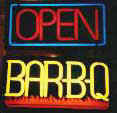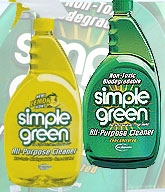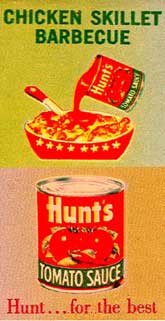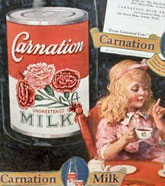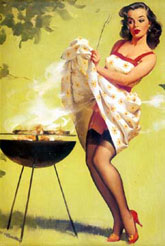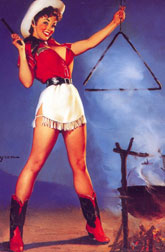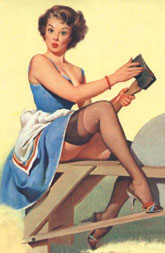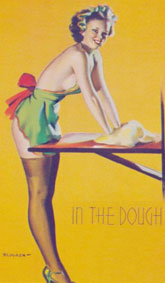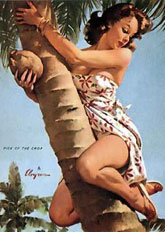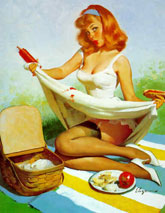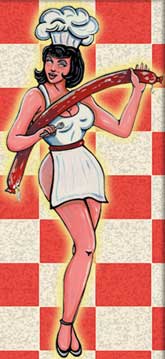Contact BBQbyDan
www.BBQDan.com
Search
KCBS BBQ Cook-Off Info
Recipes,
Smoking Meats
Recipes, Grilling
|
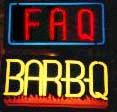 |
FAQ OF THE INTERNET BBQ LIST Version 2.0 Section 10.1 We're Smoking Meats Here - Pork Ribs |
-------------------
[Should I pay extra for a better cut of meat for barbecuing, like choice or prime?]
Harry Jiles--
The whole point of true barbecue, as per the definition which is generally accepted and discussed on this List, is to take those lower-priced cuts, which are less desired by the general public, and cook them low and slow, in the presence of smoke, and turn them into a tender, delicious and desirable meal. Anyone can buy a good cut of meat and make an excellent meal out of it, unless they screw it up, usually by overcooking it. It takes much more skill, and I believe it gives one much more personal satisfaction, to take a tough, fatty cut of meat like a brisket, and cook it until it is fork tender but still juicy and bursting with flavor.
-------------------[How do I keep the meat from sticking to my smoker grill?]
Wyndell Ferguson--
Give the grill a good spraying with Pam or other cooking spray. That'll keep the meat from sticking.
Editor--
In this section, I have included several methods from different barbecuers for each major type of barbecue meat to show that there is more than one way to get good barbecue.
--------------------[I want to barbecue some pork ribs. Can you tell me about the different kinds of ribs and how to barbecue them?]
Harry Jiles--- (Editor--Harry is a pig farmer and knows a thing or two about pork.)
There are basically three types of pork ribs, these are: spare ribs; baby back ribs; and country style ribs. Let's take a look at each type of rib.
Spare ribs are the traditional slab of ribs. They come from the belly of the pig, behind the shoulder. They include 11 to 13 long bones. There is a covering of meat on top of the bones and between them. They are the most inexpensive cut of ribs. St. Louis style ribs are a variation of the full slab. They are trimmed and have the brisket bone removed. Kansas City style ribs are another variation. They are trimmed even more than the St. Louis style ribs and have the hard bone removed.
Baby back ribs, sometimes called loin ribs, are cut from the loin section. They are shorter and smaller than spareribs. They have a covering of meat over the bones and also between them. Because they do come from the loin, they are leaner and meatier than spare ribs. They are also considerably more expensive and in shorter supply.
Country style ribs are actually not ribs at all but are cut from the blade end of the loin, right behind the upper portion of the pork shoulder. They are more like fatty pork chops than ribs. While they have more fat per pound than any of the other styles of ribs, the fat is in layers and the meat between those layers is leaner and less marbled than most other ribs. They are the meatiest of all the ribs.
Now that you know what the different rib styles are, which are the best to barbecue? A good question, which has no good answer.
First, country style ribs, because they are more like pork chops, are better for grilling than slow cooking, although they can be slow barbecued quite successfully if one keeps a close watch on them and gets them out of the smoker as soon as they are done.
Spare ribs are inexpensive and full of flavor and are probably the best choice for novice barbecuers. You won't feel near as bad if you mess up a rack of spare ribs as you will if you mess an expensive rack of baby backs. Some barbecuers, myself included, actually prefer spare ribs such as the St. Louis or Kansas City style over baby backs because they have more flavor, more meat and cost less.
Because they are the leanest of the ribs, baby backs are less messy to eat than the other ribs. They are also easier to handle than spare ribs, because they are smaller. Some barbecuers will cook nothing but baby backs and there is no question that they are excellent eating when prepared to perfection. They have a naturally sweeter flavor than spare ribs. They are more expensive than spare ribs and because they are leaner, they can be more prone to be overcooked and therefore are somewhat less forgiving to the chef. You will have to make up your own mind if they are worth the extra cost.
Smoking ribs is not at all difficult. Following are some general guidelines for cooking ribs.
If you choose spare ribs, get well trimmed ribs, such as the St. Louis style. Spare ribs also have a membrane on the bone side of the ribs. While it is not necessary to remove this membrane, the rendered fat will get away from the meat better if you remove it. The ribs will also absorb a rub or sauce better when it is removed. To remove it, carefully work the point of a blunt knife, a screwdriver or a church key under the membrane to loosen it and start to lift it from the bones. Once you have it started, you can work your fingers under it to completely separate it and tear it away.
Season both sides of the ribs generously with your favorite dry rub. If you wish, you can also marinate your ribs with a variety of liquids before seasoning. This is purely a matter of taste, as ribs cooked correctly do not need a marinade to help tenderize them. Marinades can easily overpower the true taste of the pork.
Put the ribs bone side up on the smoker grates. You can really pile a lot of ribs in a smoker if you rotate them once in a while to make sure they receive an even amount of smoke and heat. Make sure there is no flame or burning wood or charcoal under the ribs. Indirect heat is the absolute best way to cook ribs.
Most racks of ribs of 3 pounds and under will be done in approximately 3.5 to 4 hours at 200 to 225F. If the ribs are extra plump and thick it can help to bump the temperature to 250F. Baby backs will take 30 to 45 minutes less. In any case, the ribs are done when the meat is tender and will easily pull away from the bone. When they reach that point, take them out immediately.
You can poke the ribs with a fork to see how tender they are or you can gently pull and/or twist on a couple of the bones in a slab. If the ribs are done, the bone will pull away from the meat easily. After a while, you will develop a feel for doneness and you will be able to tell by just poking them with a finger.
If you wish to baste your ribs with barbecue sauce, don't do so until the last 30-40 minutes of cooking time, so the sauce does not burn on the meat. Turn the ribs over so the meat side is up and then baste with your favorite sauce. Again, this is a matter of taste, whether you want your ribs wet or dry.
As far as wood for smoking, use whatever suits your personal tastes. Hickory, oak, apple and maple are some of the commonly used woods for smoking ribs. Some like to use a combination of woods for additional flavor. I like to keep smoke on my ribs for the entire cooking period and that again, is a matter of personal taste.
Ribs are one of the traditional barbecue meats and probably on just about everybody's short list of favorite foods. So don't wait any longer. Fire up the smoker and put on some ribs. And put on a lot of ribs because all of your neighbors downwind of your smoker will probably be coming by to visit.
--------------------[Harry, what's the difference between a rack of ribs and a slab of ribs?]
I am not sure myself, but I think it is just a matter of terminology. I have always referred to the whole rib section of one side as a 'slab'. I think 'rack' is a term that the restaurant industry came up with to refer to the trimmed slabs that they usually use. Therefore, a rack is something less than a slab and how much less depends on how well trimmed it is. It seems as the two terms are somewhat ambiguous and mean different things to different folks. I am not sure if there is any set-in-stone definition.
-------------------[Harry, I like smaller racks of ribs. How come I can't find reasonably-priced ribs that are 2 and down (1 1/2 to 2 pounds per rack). Can you tell us a little about pork processors and why this is so?]
Pork processors buy their hogs on a grade and yield basis. This means they are actually buying the carcass on a lean meat basis, not the live hog on the hoof. Top price is paid for a carcass that weighs around 165-205 lbs. and has a lean meat percentage of 52-54%. Translated to live weights, this means the hog will weigh approximately 230-260 lbs. on the hoof and have 3/4" of backfat or less.
This is 30-40 lbs. heavier than what was bringing top prices just 4-5 years ago. They want the large hogs for purely economic reasons. It takes the same amount of time to run a 250 lb. hog though the plant as it does a 220 lb. hog. This 30 lbs. per hog multiplied by the numbers that they kill in a day adds up to a lot more pork and a lot of extra profit.
Even though processors want heavier hogs, they want them leaner, so the pork producers have responded by breeding animals that can put on the extra weight in lean meat and not fat. This means that today's hogs are longer, taller and bigger framed than hogs from years past. Obviously, the weight of spareribs from these animals is also going to be higher, hence the prevalence of higher weight ribs.
In order to get the 2 lb. and under ribs, you are going to have to kill smaller hogs, 220 lbs. and under (live weight). The high volume processors discount hogs at this rate which means pork producers don't send them to market, unless they have to for some reason, therefore the lack of smaller ribs. Ribs of this size are going to have to come from smaller, specialty processors who are willing to pay a premium for the smaller hogs. That cost is passed on to the consumers. Since mainstream consumers tend to buy food for as low a price as they can, there is not a great incentive for these processors to try and market the lower weight ribs to supermarkets. They are marketed to food suppliers for the restaurant industry and some of the finer meat markets. Also, since this is a lower volume market than the supermarkets, there are fewer ribs of this size available.
-------------------[I hear that a guy in Carlsbad, NM smokes a pretty mean rib. Can he share his secrets with us?]
Danny Gaulden--(Editor--Danny is the proprietor of a very successful eating establishment featuring barbecue in Carlsbad, NM and has been smoking meat for over 20 years. If you are anywhere near Carlsbad, stop by Danny's Dairy Queen for some of the best barbecue in America.)
Ah . . . Spare Ribs, definitely one of my favorites. A lot of argument has been posted on this List over the past year on ribs. Should one buy baby backs, spares, or what? I personally like spares; especially the St. Louis cut, which is hard to find. What is a St. Louis cut? It is basically a 3 1/2 and down rack that has the ends trimmed off, the bone cut off the side, and very seldom much of a flap. A Great rib. The term '3 1/2 and down' means that the slab of ribs will weigh 3 1/2 pounds or less.
How do you pick a good slab of ribs? Well, it is sometimes hard to do, considering the way most grocery stores package them today. They can be all folded up with the "bad" parts hidden. Either go to a butcher shop that will let you hand pick your slab, or ask the butcher at your favorite grocery store to let you pick out some that are not already packaged. If he won't allow you to do this, find another store. Pick a slab that is nice and thick, and has a little marbling on the meat side.
After you get them home, do some work on them yourself. I cut off the side bone that runs length-wise near one end of the slab, and trim off the skin running along the top of the flap on the bone side. Simply take a knife, hold the flap up with one hand, and cut about 1/4 inch deep all the way across it to remove the skin. With bone side up, and slab placed flat on cutting board so that bones are running in a vertical position, take a good sharp knife and make vertical cuts in flap about every 1/2 inch. Cut from the top of flap down to where it connects to the main body of the rib. Sometimes you will get lucky, and there will be no side bone, and very little flap and skin. Why do this procedure to the ribs? Usually the flap area takes longer to cook than the main body of the ribs. This procedure reduces the cooking time of the flap, and lets it get done at the same time as the rest of the slab. I have seen a lot of people overcook their ribs waiting for the flap part to finish off. If they had done this procedure, that wouldn't have happened. I do not remove the membrane on the bone side of the ribs. Never felt a need to. Maybe that's necessary for judging, but for down-home eating, I haven't found that to be the case.
Next thing I do is apply a gentle rub. Now, not a lot, for ribs are not as massive as butts and briskets. A little rub goes a long ways. Don't be afraid of it, but don't over do it. Then wrap'em up in a clear wrap, let sit in refrigerator overnight, and barbecue them the next day. If you can't let them sit all night in the refrigerator, the world won't come to an end.
Build your fire and let the ribs sit out of refrigerator while waiting for the fire to come up to temperature. I like to smoke my ribs at 240-250F, and it generally takes about 4 hours. Sometimes a little less, sometimes a little more. Just depends on the ribs.
Let me say a little about the differences in using the various styles of smoking pits. The big commercial pit in my restaurant has a rotating meat rack, like a miniature Ferris wheel inside. The meat is always turning. The temperature is quite uniform in this situation. I always barbecue ribs with the meat side up and leave them like that until they're done. You can do the same in a water smoker, where the water pan acts as a heat baffle to protect the meat from getting too hot on the bottom. In an off-set firebox pit, like my Klose Backyard Chef, I'm finding that I have to do something different. In my Klose pit, the heat comes up from below the meat and if the ribs are not turned about once an hour, I find that the side facing down is over-done. So if you're using an off-set firebox pit, like a NBBD or an SnP Pro, turn them ribs.
After the ribs have been in the pit for about an hour, I baste them with a little salad oil, then again after about 2 1/2 to 3 hours. This helps keep them moist since they have no fat cap, and I feel this in an important part of the cooking process. Use a good brand of vegetable oil. When the ribs draw up on the bone about 1/3 of an inch, and the meat between the bones becomes very fork tender, I pull them off the pit, and apply my finishing glaze immediately. By applying the glaze while the ribs are still piping hot, it will caramelize on them, and give a beautiful dark cherry-red color. They taste pretty good too!
If your fire gets out of hand and the temperature goes up to 250-275F, the ribs will draw up more on the bone, so always judge doneness by the tenderness of the meat, not draw up on bones. At cooler smoking temperatures the meat will draw up less. If your smoker temperature is higher, say in the 250-275F range, then take your ribs off sooner, maybe 3 hours instead of 4. It's that simple!
Danny's Rib and Pork Finishing glaze:
Mix the following ingredients together: 1/3 cup brown sugar, 1/3 cup yellow mustard, and 1/4 to 1/3 cup apple cider vinegar. Then heat in a saucepan until it simmers and let it sit until the ribs are ready to baste. You can substitute beer for the vinegar if you wish.
The great thing about smoking ribs is that they don't take all day to barbecue, are one of America's favorite barbecue items, and look wonderful when sliced and stacked on a serving tray. Other quick and attractive things to go with your ribs and give a great presentation, are barbecued chicken halves or quarters, and a good sausage. Stack them all together on a large platter, serve with beans, slaw, potato salad, hot bread, and a few slices of onions and pickles. Boy, good things will start to happen to you!
Update from Danny on smoking ribs--
You can start with 3 1/2 and down spareribs or loin backs. Both have their advantages and disadvantages. The advantage of 3 1/2 and down is that they are considerably cheaper and have more meat on the bone than most loin (baby) backs. In my opinion, they are every bit as good as a loin back and by far the best buy. The disadvantage is that I think they require just a bit more skill to smoke to their highest taste level and the membrane can be a bit difficult to remove compared to a loin back. The advantage of the loin back is that I think it is just a bit more tender to start with and takes a tad less skill to barbecue correctly, and the membrane removes very easily. The choice is yours to make.
One of the biggest mistakes that most beginner and intermediate level barbecuers make is buying a rib that is too lean. Let me repeat that--too lean. I want you to pick out a slab that has a fair amount of fat running up and down the bones and the meat between the bones. This is very important and will help keep your ribs from getting too dry after cooking. Don't worry about the fat, most of it will render out by the time they are finished in the smoker. There is a world of difference between a cooked slab of ribs that had good marbling in them vs. a slab that was too lean. Not only do the marbled ribs cook out more juicy, they are also far more tender.
Once you have a good slab, get it really cold in the refrigerator, or put it in the freezer for a few minutes. It is much easier to remove the membrane from very cold ribs, than barely cool or room temperature ribs. After removing the membrane, (see post below by Frank Boyer on how to remove the membrane from ribs) apply whatever a rub you like lightly to both sides of the ribs and rub it in. Don't go too heavy yet, we aren't through with the rub. Then brush on a medium coat of salad oil (Crisco, Wesson, etc.) over both sides of the slab and sprinkle on another coat of the rub (go with a medium coat this time), but don't rub it in. Just sprinkle it on. The oil will keep the rub sticking to the meat. If you try to rub it in after applying the oil, the rub will tend to ball up. Don't worry, the rub will do its job. After the ribs are rubbed, wrap them in a piece of clear wrap then place them into the refrigerator for a few hours or overnight if you have planned enough in advance. If you can't let them rest that long, don't worry about it. You can send them straight from the rub to the smoker and still produce a great rib.
Now, bring your smoker up to about 240F to a maximum of 250F and start the smoking process. Place an oven thermometer on the cooking rack about an inch or so from the ribs. This will allow you to monitor the actual temperature of the heat around the meat. Don't let the heat, at rack temperature next to the ribs, drop below about 225 to 230F. If it does, bring the fire back up to around 240-250F. If you smoke your ribs too slow, they will cook dry and come out like rib jerky and we don't want that. This is another mistake I think a lot of people make--they smoke their ribs too long and at too low of a temperature. Don't make this mistake. For the first couple of hours, baste the ribs with a mixture of about half or more cooking oil and half apple cider or juice. Baste every 45 minutes to an hour. After the ribs start to take on a shine of their own (they are starting to render their own fat), you can discontinue the basting. Depending on what kind of smoker you are using will determine if you need to turn the ribs over a couple of times, or not. After about 4 hours, your ribs should be getting near the done state. Could take 3 hours or maybe even 5. This is what make barbecuing such an inexact art.
How do you know when they are done? This can be the hardest thing to get down pat, but once you learn it is easy as pie. Take a very sharp meat fork, an ice pick, the end of your thermometer (if it has a long skinny sharp stem), etc. and stick it into the meat between the bones of the rib. If it goes in extremely easily, they are done. Should feel kind of like sticking a medium-done baked potato. Another tell tale sign is this: If you feel they are close to being done, take them off the smoker with a pair of tongs (grab the slab dead center). They should be limber and bend on each end. Also, you can lay them on a tray, then take each end about three bones in, in your hand and bend them. They will literally "crack" between the bones at the stress point when done. All this may take you a few cookings to achieve, but I know you can do it. Don't worry about having to open the smoker a few times when checking for doneness. This has to be done. You can become quite fast at this with a little practice, and you can always get the heat back up. A bigger mistake would be to be afraid of opening the smoker so much, and over cooking your meat.
If you want a "wet rib" with a glaze, the second the ribs are removed from the smoker, brush on my rib glaze given above. This must be applied while the ribs are very hot so that it will caramelize onto them. It will give them a beautiful deep dark cherry color and taste pretty darn good also. If you don't want a glaze, serve them dry. Your choice.
--------------------[I've heard that you can get some great barbecue ribs in Memphis. Can you tell me how to do this style rib on my grill?]
Richard Young--
Memphis Hogaholics Award-Winning Ribs
I used to live in Memphis and barbecue is real big there. This recipe is from the Memphis-In-May Barbecue Contest.
What you need is: 2 slabs pork spare ribs, a dry rub, some basting sauce and a wet finishing sauce.
Rub dry--rub mix onto both sides of skinned ribs. Place meat on the grill away from coals, bone side down. Cook ribs 1-1/2 to 2 hours, never turning, before using basting sauce. Cook slowly for 3-1/2 to 4-1/2 hours, basting every 45 minutes to one hour. Serve with Wet Finishing sauce on the side, or (not recommended by purists) baste with the sauce during the last 1/2 hour of cooking.
Memphis Hogaholics Award-Winning Ribs Dry Rub
Amount |
Measure | Ingredient | Preparation Method |
1 |
tablespoon | lemon peel | grated |
1 |
tablespoon | garlic powder | |
1 |
tablespoon | onion powder | |
1 |
tablespoon | chili powder | |
1 |
tablespoon | paprika | |
1 |
tablespoon | MSG | |
1/2 |
tablespoon | black pepper | |
1/2 |
tablespoon | cayenne pepper | |
1/2 |
tablespoon | white pepper | |
2 |
tablespoons | salt | |
2 |
tablespoons | sugar |
Mix together
Memphis Hogaholics Award-Winning Ribs Basting Sauce
Amount |
Measure | Ingredient | Preparation Method |
1 |
quart | vinegar | |
1 |
pint | water | |
1/2 |
small can | chili peppers | |
1 |
cup | prepared mustard | |
1-1/4 |
cup | brown sugar | |
1/2 |
stick | butter | |
1/2 |
bottle | root beer |
Combine first four ingredients in a saucepan and mix well. Cook very slowly for 1 hour. Add sugar, butter, and root beer to mixture and slow boil for 30 minutes. Recommended for pork and game.
[Editor—Based on Danny's experience, 1 cup of vegetable oil should be added to this basting sauce.]
Memphis Hogaholics Award-Winning Ribs Wet Finishing Sauce
Amount |
Measure | Ingredient | Preparation Method |
5 |
ounces | dark soy sauce | |
24 |
ounces | tomato juice | |
5 |
ounces | Worcestershire sauce | |
12 |
ounces | catsup | |
1 |
cup | apple cider vinegar | |
1 |
cup | brown sugar | |
| juice of 1 lemon | |||
1 |
teaspoon | red pepper | |
1 |
teaspoon | black pepper | |
1 |
teaspoon | dry mustard | |
1/2 |
teaspoon | garlic powder | |
1/2 |
teaspoon | onion powder | |
1/2 |
teaspoon | oregano | |
1/2 |
teaspoon | allspice | |
1/2 |
teaspoon | ginger | |
1/2 |
teaspoon | basil |
Mix all ingredients in a saucepan and simmer for 1 hour. Let sauce stand for 2 hours before serving on the side with barbecue.
The thing about this recipe is that it will depend on your smoker or grill and the size of your ribs. Memphis barbecue is over an extremely low fire so that the meat cooks very slowly. If you cannot do this on your grill, you'll have to adjust your cooking time accordingly. This is the original recipe and the time to cook it in a smoker is approximately 6 hours. However, I cannot do this on my grill because it's a gas grill and it's too hot. This is what I do. I place the ribs on one side of the grill only, I turn the burner on the other half of the grill on low. I place a smoker box over the flame with wood chips. Using this method, I can stretch out the cooking time to about 2 hours max. But it's worth the fuss. The ribs are so moist and falling apart on the inside with a nice crust on the outside.
One more piece of advice. If you have a small grill and are doing a lot of meat for a big gang, here is something I do in that situation. I cook everything in batches until nearly done, then transfer to baking pans and keep in warm oven while I start the next batch. Since the majority of cooking was done on the grill, the effect is the same. Also, seal the pans of ribs with foil when you put in the oven; grilled ribs dry out quickly in the oven.
-------------------
[How about some more good 'tried and true' rib rubs?]
Randy Dewberry--
This is Lemon Powder Rib Rub that David Klose had posted sometime ago. I just tried it on some spare ribs, smoked dry. Outstanding ribs, this will be my standard rib rub for sometime to come. I made my lemon powder from dried lemon peel that I powdered in my little coffee mill. This is for sprinkling on spareribs before you barbecue them. Use heaping measures when you are mixing it and do not skimp when you use it.
David Klose's Lemon Dry Rib Seasoning
Amount |
Measure | Ingredient | Preparation Method |
6 |
tablespoons | salt | |
6 |
tablespoons | sugar | |
1 |
tablespoon | dry lemon powder | |
2 |
tablespoons | MSG or other pep powder | |
2 1/2 |
tablespoons | black pepper | |
1 |
tablespoon | paprika |
==============
Cathy Loup--
I've been reading and enjoying John Thorne's book "Serious Pig." The section on barbecue includes this rub, which I just tried on some baby backs with excellent results. I'm pretty new to barbecue, but please trust me on this one--we all have to take a leap of faith every now and then, right?
John Thorne's Home-Grown Patent Rub
Amount |
Measure | Ingredient | Preparation Method |
1 |
teaspoon | kosher salt | |
1 |
teaspoon | hot red chile pepper | ground |
1 |
teaspoon | whole black mustard seeds | |
1 |
teaspoon | black peppercorns | gfreshly round |
3 |
whole | juniper berries | crushed |
1 |
tablespoon | peanut oil | |
1 |
tablespoon | apple cider vinegar | |
1 |
tablespoon | brown sugar | |
1 |
large clove | garlic | crushed through a garlic press |
Pound everything in a mortar (or pulse in a food processor) until it's a thick paste. If necessary, add a little hot water to thin to the consistency of bottled grainy mustard. Work the result evenly into the meat and let sit 1/2 hour or so before cooking. Recipe makes enough for 3 racks of baby backs.
==============
Don Havranek--
Well, I took Danny Gaulden's advice on cooking ribs. Got two slabs that I felt had a good marbling. I made a rub from Paul Kirk's Championship BBQ Sauce book called Doctor Dolan's Barbecue Rub. Rubbed the slabs and then lightly coated them with canola oil then sprinkled them again with some more rub. I wrapped them in plastic and refrigerated then for 8 hours. I got the smoker to 230F using hickory. I made a mop of 1 cup peanut oil and 1 cup apple juice, and seeing as Danny said it's OK to experiment, I threw in one cup of maraschino cherry juice. I basted once an hour for three hours. The last hour and a half I made his glaze of mustard, brown sugar, and vinegar and glazed the ribs a couple times. Right before I took them off (4 1/2 hours) I poured straight maraschino cherry juice over the ribs. Darn that was good. Thanks Danny!
Doctor Dolan's Barbecue Rub
Amount |
Measure | Ingredient | Preparation Method |
1/2 |
cup | dark brown sugar | |
1/2 |
cup | cane sugar | |
1/2 |
cup | garlic salt | |
1/4 |
cup | onion salt | |
3 |
tablespoons | salt | |
1 |
tablespoon | celery salt | |
1/4 |
cup | chili powder | |
1/4 |
cup | paprika | |
3 |
tablespoons | black pepper | |
1 |
tablespoon | cayenne pepper | |
2 |
teaspoons | MSG | |
1/2 |
teaspoon | allspice | ground |
1/2 |
teaspoon | oregano | dried |
1/2 |
teaspoon | summer savory | dried |
Source: Paul Kirk's Championship BBQ Sauces
-------------------
[How do I get the membrane off the ribs?]
Frank Boyer--
Removing the membrane from ribs is easy. Take a dull table knife and slide it under the membrane at the second or third bone from the end and lift the membrane up. After the membrane is loosened grab it, I grip the membrane in a bar towel and pull it off. Loin backs are easier than spare ribs, but it is no big deal. I remove the membrane even when I am doing cases of ribs. This is one of the ways to make your ribs a little better. Better smoke and spice penetration help develop better flavor. If you turn in ribs in a cook-off with the membrane still on, check your appearance and tenderness scores.
--------------------
[What's the best way to smoke beef or pork ribs on my electric water smoker?]
Jeff Lipsitt--
Smoking Beef And Pork Ribs On An Electric Water Bullet
I usually start this at 1 p.m. so we're eating at 5 or 6 p.m.. Sometimes we'll do a slab of each. Pinto beans and coleslaw are our favorite sides.
Cut and remove the membrane from the bones as best you can. At least separate each rib so they're being held together by meat, not the membrane.
Make a dry rub out of paprika (Hungarian sweet), brown sugar, garlic powder, pepper, salt, chili powder and cayenne, about 1 tablespoon of each should do it. Rub the ribs really well, put them into a plastic bag and refrigerate them overnight. Make Danny Gaulden's Mustard Glaze (see Danny's article in the Ribs section) at the same time and put it in the refrigerator, too. Then pour some Balsamic vinegar in a spray bottle.
An hour before smoking, let meat, glaze, and sauce come to room temperature. Also, start soaking hickory chips at that time. Plug in the electric bullet. Put three inches of hot water in the water pan. Put the smoking wood chips in foil with big (nickel sized) holes and put them next to the electric element. When you've got good smoke, put the ribs on the grills, bone side down. Every 30 minutes put in new bag of chips for nice medium smoke. After 2 hours, I spray the tops of the ribs with the Balsamic vinegar. Repeat every hour. Total smoking time is 4 hours at about 220-240F. Before taking the ribs off, I heat the glaze a bit in the microwave oven. Get out a huge platter and foil it. Move the ribs to the platter and immediately glaze them. Cut the ribs up individually and pig out!
-------------------
[I have an ECB and I'm having trouble getting enough ribs in the thing. Anybody got any ideas?]
Rock McNelly--
First, peel the membrane off of the back of the ribs. This will allow for smoke penetration on both sides. Then rub with your favorite dry rub and give them a good coating with vegetable oil. Now, roll them up and stick a bamboo skewer through them to keep them from unrolling. You'll be able to get 3 or 4 racks in the space of one lying flat this way. You just have to turn them over once in a while. World renowned Executive Chef, Paul Kirk, teaches this method.
==============
Editor--
Barbecue stores and suppliers sell a device called a rib rack. It allows you to stand 2-3 racks of ribs vertically on your smoker's meat rack. They cost $15-20. Check with BBQ Pits by Klose for an all stainless steel rib rack.
You can download all the recipes in this FAQ ![]() Click here
Click here
Go to the next section
Return to the Table of Contents
Return to the BBQ FAQ Home Page
Comments or Suggestions
BBQ FAQ Ver 1.0, 2.0 ©1997, 1998 William W. Wight. All rights reserved.

